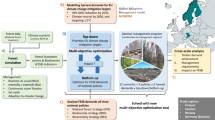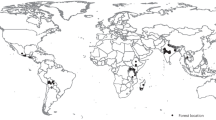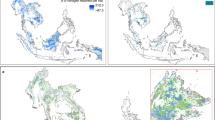Abstract
There has been extensive debate about whether the sustainable use of forests (forest management aimed at producing a sustainable yield of timber or other products) results in superior climate outcomes to conservation (maintenance or enhancement of conservation values without commercial harvesting)1,2,3,4,5,6,7,8. Most of the relevant research has relied on consequential life-cycle assessment (LCA), with the results tending to show that sustainable use has lower net greenhouse-gas (GHG) emissions than conservation in the long term1,2,3,4,5. However, the literature cautions that results are sensitive to forest- and market-related contextual factors: the carbon density of the forests, silvicultural and wood processing practices, and the extent to which wood products and forest bioenergy displace carbon-intensive alternatives. Depending on these issues, conservation can be better for the climate than sustainable use1,6,7,8. Policy institutions are another key contextual factor but, so far, they have largely been ignored1,2,3,4,5,6. Using a case study on the Southern Forestry Region (SFR) of New South Wales (NSW), Australia, we show how policy institutions can affect the assessed outcomes from alternative forest management strategies. Our results highlight the need for greater attention to be paid to policy institutions in forest carbon research.
This is a preview of subscription content, access via your institution
Access options
Subscribe to this journal
Receive 12 print issues and online access
$209.00 per year
only $17.42 per issue
Buy this article
- Purchase on Springer Link
- Instant access to full article PDF
Prices may be subject to local taxes which are calculated during checkout



Similar content being viewed by others
References
Bustamente, M. et al. in Climate Change 2014: Mitigation of Climate Change (eds Edenhofer, O. et al.) Ch. 11 (IPCC, Cambridge Univ. Press, 2014).
Nabuurs, G. J. et al. in Climate Change 2007: Mitigation (eds Metz, B. et al.) Ch. 9, (IPCC, Cambridge Univ. Press, 2007).
Perez-Garcia, J., Lippke, B., Comnick, J. & Manriquez, C. An assessment of carbon pools, storage, and wood products market substitution using life-cycle analysis results. Wood Fibre Sci. 37, 140–148 (2005).
Sathre, R. & O’Connor, J. Meta-analysis of greenhouse gas displacement factors of wood product substitution. Environ. Sci. Policy 13, 104–114 (2010).
Lippke, B. et al. Life cycle impacts of forest management and wood utilization on carbon mitigation: Knowns and unknowns. Carbon Manage. 2, 303–333 (2011).
Lamers, P. & Junginger, M. The ‘debt’ is in the detail: A synthesis of recent temporal forest carbon analyses on woody biomass for energy. Biofuels Bioprod. Biorefin. 7, 373–385 (2013).
Zanchi, G., Pena, N. & Bird, N. Is woody bioenergy carbon neutral? A comparative assessment of emissions from consumption of woody bioenergy and fossil fuel. Glob. Change Biol. 4, 761–772 (2012).
Mitchell, S. R., Harmon, M. E. & O’Connell, K. Carbon debt and carbon sequestration parity in forest bioenergy production. Glob. Change Biol. 4, 818–827 (2012).
Powell, W. W. & DiMaggio, P. J. (eds) The New Institutionalism in Organizational Analysis (Univ. Chicago Press, 1991).
Hodgson, G. M. What are institutions? J. Econ. Issues 40, 1–25 (2006).
Sandén, B. A. & Karlström, M. Positive and negative feedback in consequential life-cycle assessment. J. Clean. Prod. 15, 1469–1481 (2007).
Finnveden, G. et al. Recent developments in life cycle assessment. J. Environ. Manage. 91, 1–21 (2009).
Ostrom, E. Governing the Commons: The Evolution of Institutions for Collective Action (Cambridge Univ. Press, 1990).
Ximenes, F., George, B., Cowie, A., Williams, J. & Kelly, G. Greenhouse gas balance of native forests in New South Wales, Australia. Forests 3, 653–683 (2012).
Oliver, C. D., Nassar, N. T., Lippke, B. & McCarter, J. B. Carbon, fossil fuel, and biodiversity mitigation with wood and forests. J. Sustain. For. 33, 248–275 (2014).
Lamers, P., Junginger, M., Dymond, C. C. & Faaij, A. Damaged forests provide an opportunity to mitigate climate change. Glob. Change Biol. 6, 44–60 (2014).
NSW Forest Agreements Implementation Reports 1999 to 2010 (NSW Government, 2004 to 2011).
Integrated Forestry Operations Approval Annual Reports, Eden and Southern RFA Areas 2001 to 2013 (Forestry Corporation of NSW, 2001 to 2013).
Hiraishi, T. et al. (eds) 2013 Revised Supplementary Methods and Good Practice Guidance Arising from the Kyoto Protocol (IPCC, 2014).
Australian Bureau of Agricultural and Resource Economics and Sciences Australian Forest and Wood Products Statistics (Commonwealth of Australia, 2014).
Eggleston, S. et al. 2006 IPCC Guidelines for National Greenhouse Gas Inventories (Institute for Global Environmental Strategies, 2006).
Sawn Timber in Australia 2012–2026 (BIS Shrapnel, 2012).
Whittle, L., Berry, P. & Heyhoe, E. Leakage from Avoided Clearing and Harvesting of Native Forests under the CFI: A Quantitative Assessment (Commonwealth of Australia, 2013).
Macintosh, A. The Australian Native Forest Sector: Causes of the Decline and Prospects for the Future (The Australia Institute, 2013).
Australian Government Emissions Reduction Fund White Paper (Commonwealth of Australia, 2014).
Forests NSW Performance Audit Report: Yield Forecasts – Southern Regional Forest Agreement, South Coast Sub-region (NSW Government, 2011).
Forests NSW Performance Audit Report: Yield Forecasts – Southern Regional Forest Agreement, Tumut Sub-region (NSW Government, 2011).
Forests NSW Performance Audit Report: Yield Forecasts – Eden Regional Forest Agreement (NSW Government, 2011).
NSW Government NSW Forest Agreements Implementation Report 2008–2009 (NSW Government, 2011).
NSW Government NSW Forest Agreements Implementation Report 2009–2010 (NSW Government, 2011).
Australian Government National Inventory Report 2012: The Australian Government Submission to the United Nations Framework Convention on Climate Change (Commonwealth of Australia, 2014).
Richards, G. & Evans, D. Development of a carbon accounting model (FullCAM vers. 1.0) for the Australian continent. Aust. For. 67, 277–283 (2004).
NSW Government Integrated Forestry Operations Approval for the Southern Region (NSW Government, 2013).
Ximenes, F., Gardner, W. D. & Marchant, J. Total Biomass Measurement and Recovery of Biomass in Log Products in Spotted Gum (Corymbia maculata) Forests of SE NSW (Commonwealth of Australia, 2005).
Rothe, A. Forest Biomass for Energy: Current and Potential Use in Tasmania and a Comparison with European Experience (University of Applied Sciences, Weihenstephan, 2013).
Farine, D. R. et al. An assessment of biomass for bioelectricity and biofuel, and for greenhouse gas emission reduction in Australia. Glob. Change Biol. 4, 148–175 (2012).
Illic, J., Boland, D., McDonald, M., Downes, G. & Blackmore, P. Wood Density Phase 1—State of Knowledge (Commonwealth of Australia, 2000).
Bertalanffy, L. Quantitative laws in metabolism and growth. Q. Rev. Biol. 32, 217–231 (1957).
Richards, F. J. A flexible growth function for empirical use. J. Exp. Bot. 10, 290–300 (1959).
Richards, G. et al. Developing a carbon stocks and flows model for Australian wood products. Aust. For. 70, 108–119 (2007).
Tucker, S. N. et al. Life Cycle Inventory of Australian Forestry and Wood Products (Forest Wood Products Australia, 2009).
Greenhouse Gas Impact Assessment: 5.5 MW Biomass Power Plant—Report prepared for South East Fibre Exports (URS, 2009).
Australian Government Australian National Greenhouse Accounts: National Greenhouse Accounts Factors (Commonwealth of Australia, 2013).
State Forests of NSW Social, Environmental and Economic Reports (Forestry Commission of NSW, 2000–2003).
Forests NSW Social, Environmental and Economic Reports (NSW Government, 2004–2007).
Forests NSW Annual Reports (NSW Government, 2008–2012).
Bureau of Rural Sciences Australia’s State of the Forests Report 2003 (Commonwealth of Australia, 2003).
Annual Report 2012–13: Sustainability Supplement (Forestry Corporation of NSW, 2013).
FAOSTAT: ForesSTAT (FAO, 2014).
Timber Market Survey (URS, 2014).
Sein, C. C. & Mitlöhner, R. Eucalyptus Urophylla S. T. Blake: Ecology and Silviculture (CIFOR, 2011).
Emission Factors Compilation (WRI, 2012).
Brander, M. et al. Electricity-Specific Emission Factors for Electricity Generation (Ecometrica, 2011).
Berry, N. J. et al. The high value of logged tropical forests: lessons from northern Borneo. Biodivers. Conserv. 19, 985–997 (2010).
Ziegler, A. D. et al. Carbon outcomes of major land-cover transitions in SE Asia: Great uncertainties and REDD + policy implications. Glob. Change Biol. 18, 3087–3099 (2012).
Gibbs, H. et al. Monitoring and estimating tropical carbon forest stocks: Making REDD a reality. Environ. Res. Lett. 2, 045023 (2007).
Buhaug, Ø. et al. Second IMO GHG Study 2009 (International Maritime Organization, 2009).
Smith, T. et al. Third IMO GHG Study 2014 (International Maritime Organization, 2014).
Koop, K., Koper, M., Bijsma, R., Wonink, S. & Ouwens, J. D. Evaluation of Improvements in End-Conversion Efficiency for Bioenergy Production (European Commission, 2010).
Clean Energy Regulator Greenhouse and Energy Information 2012–2013 (Commonwealth of Australia, 2014).
Australian Government Strong Growth, Low Pollution: Modelling a Carbon Price (Commonwealth of Australia, 2011).
Author information
Authors and Affiliations
Contributions
A.M. designed the research, analysed data, created the models and drafted and revised the paper. H.K. assisted with data analysis and drafting and revising the paper. D.L. helped draft and revise the paper.
Corresponding author
Ethics declarations
Competing interests
A.M. is the Chair of the Australian Emissions Reduction Assurance Committee, a statutory body responsible for overseeing carbon offset methods developed for the purpose of the Australian Government’s Emissions Reduction Fund. The content of the letter reflects his personal views, not those of the Committee or the Australian Government.
Supplementary information
Rights and permissions
About this article
Cite this article
Macintosh, A., Keith, H. & Lindenmayer, D. Rethinking forest carbon assessments to account for policy institutions. Nature Clim Change 5, 946–949 (2015). https://doi.org/10.1038/nclimate2695
Received:
Accepted:
Published:
Issue Date:
DOI: https://doi.org/10.1038/nclimate2695
This article is cited by
-
Wood substitution potential in greenhouse gas emission reduction–review on current state and application of displacement factors
Forest Ecosystems (2021)
-
Exploring development and evolutionary trends in carbon offset research: a bibliometric perspective
Environmental Science and Pollution Research (2021)
-
Policy institutions and forest carbon
Nature Climate Change (2016)



